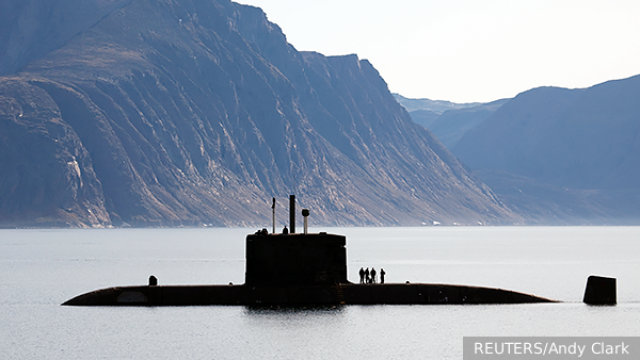The struggle for the Arctic is escalating. Another country, Canada, joins the rivals of the Russian Navy underwater. What kind of submarine fleet does Canada have today, what is it planning to replace it with, what threat will it pose to our country – and what could we counter it in the end?
Most of the Arctic Ocean is covered with ice – and this fact is of great importance for ensuring Russia's security. It is under the ice cap that Russian strategic missile submarines with ballistic missiles are hiding from American patrol aircraft. Equally important are the tasks of Russian multipurpose nuclear submarines, which, in addition to protecting their missile defense systems, must also fight the enemy's submarines.
The importance of Canada for the submarine fleet
Today, only the United States and theoretically (if they return their submarines to combat capability) the United Kingdom pose a threat to Russia in this sense. This is due to the fact that only these countries have nuclear submarines, direct access to the Arctic Ocean, and experience of sailing under ice. All other Arctic NATO countries do not have nuclear submarines.
Canada does not have them either. At the moment, its submarine fleet consists of four British-built diesel-electric submarines of the Victoria type. The laying of the first of these submarines took place as early as 1983, and the beginning of service for the entire series fell at the beginning of the 1990s.
Now it is worth paying attention to the specifics of the seas surrounding Canada. In the north, between the Arctic Ocean and the North American continent, there is the world's largest Canadian Arctic archipelago, the straits between the islands of which allow passage by water from the Arctic Ocean to the Atlantic, bypassing the English Channel or the Faroe-Icelandic border. Naturally, they only allow it in summer, and in winter only nuclear submarines can pass there.
Canada is a NATO member country hostile to Russia. Knowledge of the straits of the Canadian Arctic Archipelago is important for the defense of Russia's maritime borders. At the beginning of the 21st century, Canadians were unpleasantly surprised to learn that our maps of the depths in their straits are better than they have. And if the United States can act in the straits of the Canadian archipelago against our submarines, then Canada cannot.
And now the situation will begin to change. In July, Canada announced plans to replace existing old submarines with new ones and simultaneously increase their number to 12 units.
The renewal of the Canadian Fleet and its consequences
Modern non-nuclear submarines (NPS), as a rule, have an air-independent power plant (VNEU) or lithium-ion batteries (Japanese Taigei-type NPS, for example). Both allow them to stay underwater for many times longer than traditional diesel-electric submarines could. And this makes it possible to conduct not only underwater, but also ice swimming.
Naturally, such a submarine will never compare in terms of autonomy and a number of other capabilities with a nuclear one. Nevertheless, upon receipt of new submarines from VNEU, the forces of the Canadian Navy will significantly increase.
If not along the entire length of their northern sea communications (and the so-called Northwest Passage passes through the straits of the Canadian Arctic Archipelago – the Canadian alternative to the Northern Sea Route), then Canadian submarines will be able to go under the ice at the entrances and exits.
And then, from the point of view of confrontation under water, the quality of acoustics and torpedoes will matter. In straits with difficult ice conditions, a secretive non-nuclear submarine with a high-class sonar system and modern torpedoes will prove to be a deadly enemy for any nuclear submarine. Moreover, you can be sure that she will "win" the first shot. This can seriously change the balance of power in some cases.
Do not forget about the offensive capabilities of the United States and Canada. Unlike American submarines, Canadian submarines can lie on the bottom near Russian naval bases, primarily in Kamchatka. And the increased number of new submarines (12 against four now) will allow them to be deployed in several directions.
Today, Canada has three submarines based in the Pacific Ocean, and another in the Atlantic. Due to their obsolescence and wear, the threat they pose to us is not so significant. But new submarines can radically change everything – and not in our favor.
Back in 2020, Canadian sailors began exploring all existing options for non-nuclear submarines. French, Japanese, South Korean, Swedish, Spanish and German versions were considered. At the moment, it is known that the German ThyssenKrupp concern, the Spanish Navantia, the South Korean Hanwa Group and the Swedish SAAB concern have shown interest in supplying submarines to Canada. For Russia, the worst option would be a German submarine. However, the rest of the submarines are extremely dangerous.
What should be Russia's response?
What is needed here? First of all, in principle, take into account the new threat. Organizational and operational countermeasures are needed.
The expansion of the threat underwater requires Russia to resume work on equipping our submarines with anti-torpedoes. Especially atomic ones. There is no other reliable means of protection against modern foreign torpedoes yet. Due to the combination of tactical and technical characteristics of the homing systems of Western torpedoes and the tactical techniques used, sonar countermeasures will prove ineffective.
In general, it should be understood that the replacement of four half-dead "Victorias", for example, with 12 German boats of the 212 project in some Canadian version is a threat that cannot be dismissed. Fortunately, we have time to prepare – Canada will not have these submarines instantly. You just need to use this time properly.
Alexander Timokhin



